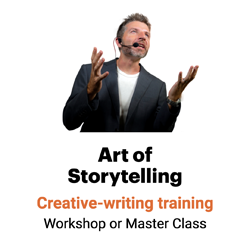The gift that keeps on giving
Quick! Which is more effective?

A simple metaphor?
Bobby Holloway says my imagination is a three-hundred-ring circus.
— Dean Koontz in Seize the Night
Or an extended metaphor?
Bobby Holloway says my imagination is a three-hundred-ring circus. Currently I was in ring two hundred and ninety-nine, with elephants dancing and clowns cart wheeling and tigers leaping through rings of fire. The time had come to step back, leave the main tent, go buy some popcorn and a Coke, bliss out, cool down.
— Dean Koontz in Seize the Night
The extended metaphor — one that continues through a series of sentences — is nearly twice as persuasive as a simple metaphor, according to Pradeep Sopory and James Price Dillard’s review of 50 years of research.
So extend your metaphors.
Proper investment advice is like bespoke tailoring.
When I was editing a mutual fund company’s marketing magazine, we decided to compare customized investment advice to bespoke tailoring.
We could sustain that from the headline …
Perfect fit
… through the deck …
One size never really does fit all. Here’s how to tailor your portfolio to your own needs and dreams
… through the subheads …
Measure twice, cut once
Tailored fit
Start with these patterns
… through subtle references throughout the article …
…
Ready-to-wear models that split your ideal allocation into stock and bond slices depending on your age are a starting point. But the perfect portfolio isn’t just about how old you are. After all, if you ask 10 people where they want to be in 10 years, you’ll get 10 answers.
…
A more tailored approach meets a broad range of needs and takes advantage of the diverse array of investment options — from blue chips to emerging markets — in proportions that make sense at your stage.
See Ann’s extended metaphor on horseback racing.
How to write an extended metaphor
So how do you write an extended metaphor?
First, you need to understand the mathematics of metaphor. The math behind this literary device is simple:
X = Y.
Meaning passes from the base to the target, from Y to X. In “Romeo and Juliet,” William Shakespeare writes:
Juliet is the sun.
Or:
X [Juliet] is Y [the sun].
Metaphor links X to Y:
X is the target.
Y is the base.
Then extend your metaphor by exploring the base. Here’s how:
1. Choose your base.
“If you want to try an extended metaphor, think carefully about your comparison entity,” writes Nancy Kress in Writer’s Digest.
“Choose something that is specific and concrete, like a diamond. Then jot down three or more similarities between that and your original object or situation. Finally, describe the latter in terms of the former, playing with the actual words until the comparisons are both clear and enlightening.”
The sun, maybe.
2. Explore your base.
Now delve deeper into the base to find more specific elements:
- Light
- East
- Moon
- Etc.
3. Compare your topic to these elements.
Now construct metaphors comparing your topic to the items on your list. Here’s Shakespeare:
But soft! What light through yonder window breaks?
It is the east, and Juliet is the sun.
Arise, fair sun, and kill the envious moon,
Who is already sick and pale with grief …
Extend metaphors like William Shakespeare
See how Emily Dickinson extends her base, a bird, in “Hope Is a Thing With Feathers”:
“Hope” is the thing with feathers —
That perches in the soul —
And sings the tune without the words —
And never stops — at all —
And sweetest — in the Gale — is heard —
And sore must be the storm —
That could abash the little Bird
That kept so many warm —
You’ll see an extended base in Robert Frost’s “The Road Not Taken” (“Two roads diverged in a yellow wood …”) And in Animal Farm by George Orwell. In fact, you’ll find this literary device in all of the best writing.
Why not yours?
Caravaggio is like chiaroscuro.
In Caravaggio: A Life Sacred and Profane, Andrew Graham-Dixon compares the artist to the chiaroscuro — the lightest lights and darkest darks — of his paintings. Notice how the author explores the base to extend the metaphor:
He was one of the most electrifyingly original artists ever to have lived …
He lived much of his life as a fugitive, and that is how he is preserved in history — a man on the run, heading for the hills, keeping to the shadows.
But he is caught, now and again, by the sweeping beam of a searchlight.
His youth is the least documented period of his existence — the darkest time, in every sense, of this life of light and darkness.
But in its shadows may be found some of the most important clues to the formation of his turbulent personality.
…
Bellori, echoing Vasari’s idea that artists resemble their own work, wrote that “Caravaggio’s style corresponded to his physiognomy and appearance; he had a dark complexion and dark eyes, and his eyebrows and hair were black; this colouring was naturally reflected in his paintings … driven by his own nature, he retreated to the dark style that is connected to his disturbed and contentious temperament.”
How can you explore your base to extend your metaphor?
____
Sources: James Geary, “Metaphorically Speaking,” TedTalks, July 2009
*Nancy Kress, “O My Luve’s Like A Red, Red Rose,” Writer’s Digest, February 2000
George Lakoff and Mark Johnson, Metaphors We Live By, University of Chicago Press, 2003
Pradeep Sopory and James P. Dillard, “The Persuasive Effects of Metaphor: A Meta-Analysis,” Human Communication Research, July 2002

Leave a Reply